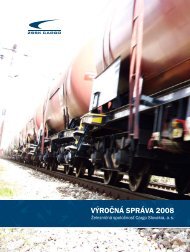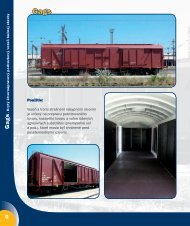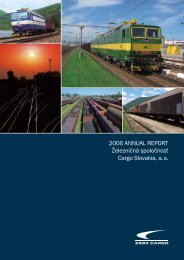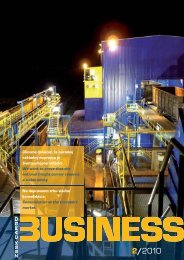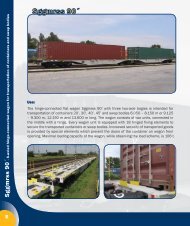CARGO BUSINESS 1-10.indd - ZSSK Cargo
CARGO BUSINESS 1-10.indd - ZSSK Cargo
CARGO BUSINESS 1-10.indd - ZSSK Cargo
- No tags were found...
Create successful ePaper yourself
Turn your PDF publications into a flip-book with our unique Google optimized e-Paper software.
Prístav Hamburg je jednou zo základní nemeckého hospodárstva<br />
Port of Hamburg is one of the pillars of<br />
German economy<br />
Prostredníctvom Prístavu Hamburg prúdia tovarové toky po mori<br />
z Ázie do Európy. Kríza však zasiahla aj svetovú kontajnerovú námornú<br />
dopravu. Po šesťročnej šnúre nepretržitého rastu, ktorý sa pohyboval<br />
v dvojciferných číslach, v roku 2008 nastal zvrat. Takto charakterizoval<br />
námorný obchod Vladimír Doboš z Prístavu Hamburg vo svojom<br />
príspevku na konferencii <strong>ZSSK</strong> <strong>CARGO</strong> vo Vysokých Tatrách 29.<br />
októbra.<br />
Nárast svetovej námornej prepravy kontajnerov v roku 2008 dosahoval<br />
len 5,4 percenta a odhady na rok 2009 vyzerajú na dvojciferný<br />
pokles, cca o 10,3 percenta. Pokles v exporte i importe je citeľný aj<br />
u najväčších obchodných partnerov Prístavu Hamburg. - Prax ukazuje,<br />
že v súčasnosti je 10 percent líniových kontajnerových prepráv<br />
po mori nadbytočných. Najvyššie číslo sa týka prepráv z východnej<br />
a juhovýchodnej Ázie. Predpokladáme, že situácia by sa mala ustáliť<br />
okolo roku 2015, - argumentoval V. Doboš.<br />
Stratu v odhadovanej výške okolo 20 miliárd dolárov v tomto roku<br />
vygenerujú všetky rejdarské spoločnosti. Znížený dopyt po prepravách<br />
sa snažia spoločnosti kompenzovať znížením rýchlostí lodí, čím<br />
sa znížia náklady na palivá, a tým aj cena za poskytované služby.<br />
Nevýhodou však je predĺženie tranzitnej dopravy o sedem až dvanásť<br />
dní. -Prístav má pripravených viac investičných projektov, medzi ktoré<br />
patrí aj dostavba a úpravy dvoch najväčších terminálov kombinovanej<br />
dopravy – Eurogate a Burchardkai, - približuje investičnú stratégiu<br />
V. Doboš.<br />
Atraktivita prístavu Hamburg spočíva v obsluhe zázemia. Hamburg<br />
je zároveň najvýznamnejší európsky železničný prístav. - Prístav je<br />
svetovou dvojkou – celkovo je z tohto miesta týždenne vypravených<br />
viac ako 1300 nákladných vlakov, z nich je viac než 750<br />
intermodálnych. Po železnici tak do cieľových destinácií v Európe<br />
odchádza 34 percent nákladov, - kvantifikuje železničné prepravy<br />
V. Doboš. Na fungovaní a rozvoji prístavu Hamburg v čase krízy má<br />
záujem aj nemecká vláda, ktorá podporuje všetky nemecké prístavy.<br />
Pozitívnou informáciou je, že už v 3. štvrťroku došlo k oživeniu prepráv<br />
v prístave a je reálny predpoklad, že k prehlbovaniu poklesu nedôjde.<br />
(ms)<br />
By means of this port, goods flows are transported by sea from Asia<br />
to Europe. But the crisis has also affected the global container sea<br />
transport. After six years of continuous percentual growth, achieving<br />
two-digit figures, there was a turn in 2008. This is how Mr. Vladimír<br />
Doboš from the port of Hamburg characterized the sea-borne trade in<br />
his contribution to the conference of <strong>ZSSK</strong> <strong>CARGO</strong>, held in the High<br />
Tatras on 29.October.<br />
The increase in global sea transportation of containers reached only<br />
5.4 percent in 2008 and estimations for 2009 indicate a double-digit<br />
decline of about 10.3 per cent. This significant decline in export and<br />
import has also been notable at major business partners of the port. -<br />
Experience shows that 10 percent of line container transportations,<br />
made by sea currently, are excessive. The highest number is related<br />
to transportations from the East and Southeast Asia. We assume<br />
that the situation should be stabilized around 2015 – V. Doboš<br />
mentioned.<br />
This year, loss estimated at around 20 billion U.S. dollars will be<br />
generated by all shipping companies. The companies are trying<br />
to compensate lower demand for transportations by reduction in<br />
speed of their ships, thereby reducing the costs of fuel and the price<br />
for services provided. The disadvantage, however, is an increase in<br />
duration of transit transport by seven to twelve days. –There is several<br />
investment projects prepared for the port. These include completion<br />
and refurbishment of two major terminals of combined transport<br />
- Eurogate and Burchardkai – V. Doboš detailed the investment<br />
strategy.<br />
The attractiveness of the port of Hamburg is its operation of<br />
hinterland. Hamburg is also the most important European railway<br />
port. – The port is the world’s number two – more than 1 300 freight<br />
trains, of which more than 750 are intermodal, are dispatched from<br />
this location per week. 34 percent of loads are transported to their<br />
final places of destination in Europe by rail – V. Doboš presented<br />
the figures on rail transportations. Also, the German government,<br />
supporting all the German ports, is interested in operation and<br />
development of the port of Hamburg in times of crisis. Positive<br />
information is that already in the 3rd quarter, the port indicated<br />
a recovery in transportations and one can assume that there will be no<br />
further decline.<br />
(ms)<br />
Prekládka nákladu prepravovaného po mori v prístave Hamburg (v mil.<br />
ton) Zdroj: Hafen Hamburg Marketing<br />
Transhipment of load transported by sea in the port of Hamburg (in<br />
mil. tonnes) Source: Hafen Hamburg Marketing<br />
Preprava kontajnerov v prístave Hamburg za 1. štvrťrok 2009 (v mil. TEU)<br />
Zdroj: Hafen Hamburg Marketing<br />
Transportation of containers in the port of Hamburg for the 1st quarter<br />
of 2009 (in mil. TEU) Source: Hafen Hamburg Marketing<br />
16/17








